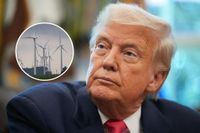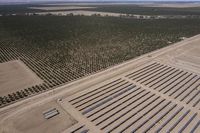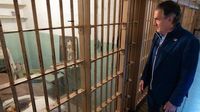On August 20, 2025, the renewable energy sector in the United States found itself in the crosshairs of a heated political debate, as President Donald Trump unleashed a series of pointed criticisms against wind and solar power projects. His remarks, delivered on his preferred social media platform, Truth Social, sent ripples through both the energy markets and the agricultural community, igniting fresh concerns about the future trajectory of clean energy policy in the country.
Trump’s latest salvo was direct and unmistakable: “Stupid and ugly windmills are killing New Jersey. Energy prices up 28% this year, and not enough electricity to take care of the state. Stop the windmills,” he wrote, according to Bloomberg News. The president’s post came at a time when energy prices in New Jersey have indeed climbed sharply—up 28% since the beginning of the year, a fact that has not gone unnoticed by residents and businesses alike. Yet, as several sources with knowledge of the matter explained to Bloomberg, the primary drivers behind these price hikes are not windmills, but rather a surge in demand from energy-hungry data centers and a lack of new energy projects to keep up with that demand.
But Trump’s criticisms did not stop at wind farms. On the very same day, he declared that his administration would not approve wind or solar projects that harm farmland, alleging that such projects are inflating electricity prices and threatening agricultural livelihoods. "We will not approve wind or farmer destroying Solar," Trump posted, adding, "The days of stupidity are over in the USA!!!" These comments followed a significant policy move by the U.S. Department of Agriculture, which, on August 19, 2025, announced it would end programs providing financial support to clean energy projects on productive farmland. This decision, as reported by Bloomberg, presents new challenges for growers who have come to rely on federal incentives to diversify their income amid persistently low crop prices.
The financial consequences of Trump’s remarks were felt almost immediately. U.S.-based wind turbine manufacturer GE Vernova, which had been enjoying a strong year on the back of booming orders for gas turbines to power data centers, saw its stock slide by 3.9% to $600.40 on August 20. The drop, reported by Bloomberg News, reflected broader investor anxiety about the political headwinds facing renewable energy companies—especially those supplying hardware for the rapidly expanding artificial intelligence data center market.
Yet, the debate over renewables and rising electricity prices is not as straightforward as Trump’s posts might suggest. According to Lawrence Berkeley National Laboratory data cited by Bloomberg, solar and battery storage projects make up the overwhelming majority of new projects waiting to connect to the grid. These technologies, experts argue, are among the fastest ways to address the supply-demand gap that has sent electricity prices soaring in regions like New Jersey and across the PJM Interconnection—the nation’s largest grid, covering 13 states in the Mid-Atlantic, Midwest, and South. In July 2025, PJM Interconnection saw prices for new power capacity rise 22% compared to the previous year, a spike largely attributed to the rapid growth of data centers and the retirement of older coal plants.
For many in the renewable energy sector, Trump’s latest attacks are part of a broader, sustained campaign against clean energy that began shortly after he took office. The administration’s One Big Beautiful Bill Act, for instance, seeks to terminate the investment and production tax credits that have fueled the expansion of wind and solar power in the U.S. for years. If the act is enacted as planned, those credits will disappear by the end of 2027, making it significantly harder for new renewable projects to get off the ground. Meanwhile, Trump’s imposition of steel and copper tariffs has increased the costs of building solar and wind installations, further squeezing companies already facing an uncertain regulatory environment.
Adding to the regulatory squeeze, the administration in July 2025 centralized the federal permitting process for renewable projects under Interior Secretary Doug Burgum, making it more difficult for companies to obtain the approvals they need. As reported by Bloomberg, renewable energy firms worry that projects which once sailed through routine permitting may now become mired in bureaucratic delays or be denied altogether. The president’s comments this week have only heightened those fears.
Trump’s stance has found support among some agricultural groups and landowners who worry about the impact of large-scale solar and wind farms on productive farmland. The president has often complained that solar panels take up too much land, echoing concerns from some farmers who argue that clean energy projects can disrupt traditional agriculture and rural landscapes. With the U.S. Department of Agriculture’s decision to end support for solar on farmland, growers who have leaned on federal incentives to weather tough times in the agricultural sector are now facing a new set of financial challenges.
Still, not everyone is convinced by the administration’s argument that renewables are the main culprit behind rising energy costs. As experts told Bloomberg News, the real story is more nuanced: surging demand from data centers—especially those supporting artificial intelligence and cloud computing—has strained existing power supplies, while the retirement of older generating plants and a lack of new energy infrastructure have left some regions struggling to keep up. In this context, renewables like solar and battery storage, which can be brought online relatively quickly, are seen by many as essential tools for stabilizing the grid and keeping prices in check.
Industry analysts point out that the U.S. is at a crossroads when it comes to its energy future. The combination of political opposition, regulatory hurdles, and market pressures is creating uncertainty for investors and developers alike. At the same time, the pressing need for more electricity—driven by everything from AI data centers to electric vehicles—means that finding reliable, affordable, and sustainable sources of power has never been more urgent.
As the debate rages on, the fate of America’s renewable energy sector hangs in the balance. With the administration doubling down on its opposition to wind and solar projects, and with critical tax credits and federal support set to disappear in the coming years, the path forward is anything but clear. For the communities, companies, and consumers caught in the middle, the stakes could hardly be higher.
What happens next may well determine not just the price of electricity, but the shape of America’s energy landscape for years to come.






